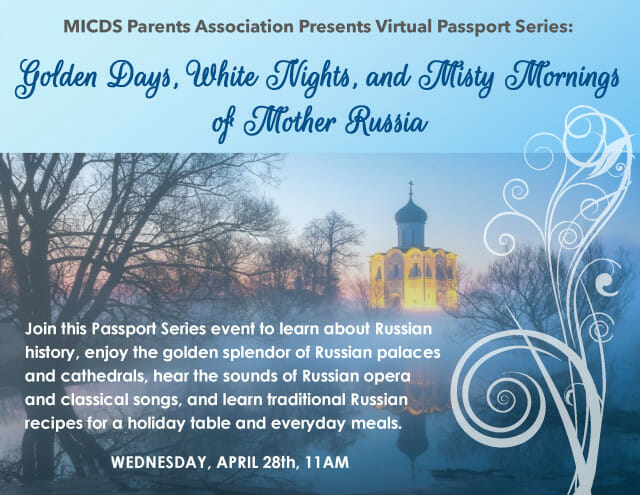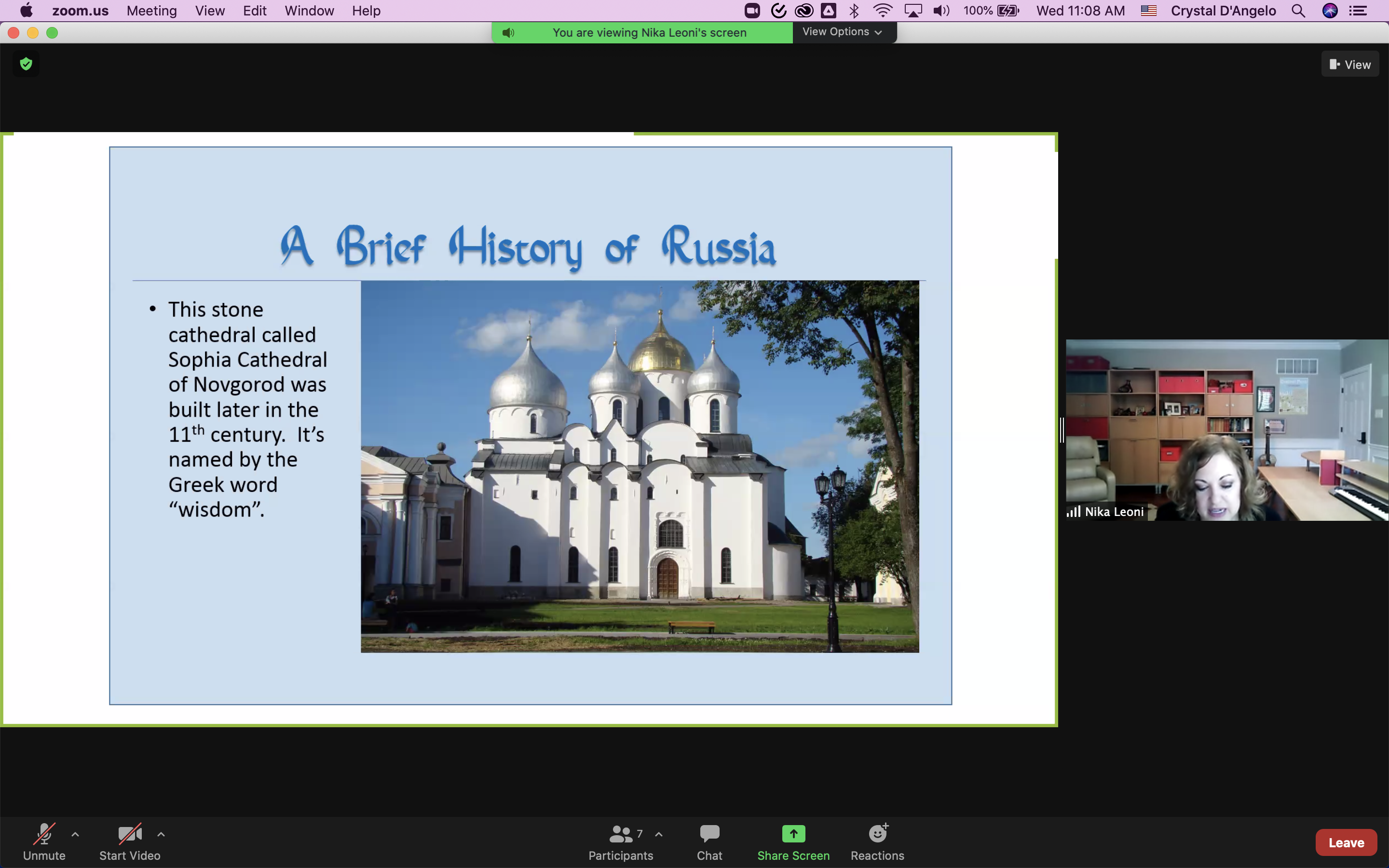On Wednesday, the MICDS Passport Series met virtually to learn all about Russia from MICDS parent Nika Leoni. Nika presented on Russian history, palaces and cathedrals, opera and classical songs, and traditional Russian recipes. Having lived in Russia for the first 20 years of her life, Nika was a wealth of information for fellow MICDS parents/guardians and employees who really enjoyed the opportunity to learn all about her native country.

Russian History
To paint the picture of Russian history, Nika shared that the inhabitants of Russia in ancient times were Slavic tribes. She went through the periods of time where different groups of people came to the country and obtained power. A few notable times included the Vikings coming in 800 AD from Sweden, assimilating with the Slavs and Finns who adopted the Viking culture (i.e. military attire). Attendees learned that the Vikings were called “Rus” which is where Russia gets its name from.
Soon, the Viking culture fused with Byzantine style which turned into the unique Russian style that incorporates a lot of gold. Power also evolved as Vladimir the Great helped to expand the country under his rule. In the 13th century, 300 years of submission to Mongol rule began due to the invasion by Mongol-Tartars.
In the 15th century, the Mongols were defeated by the Grand Prince of Moscow, and power shifted to Moscow. Ivan the Great helped reconstruct the Moscow Kremlin. Following, Ivan the Terrible further expanded Russian power even through a dictatorial leadership style. At these times, the Greek Orthodox Church influenced Russian religious development. A period of unrest and invasions followed until Mikhail Romanov, the first Russian Tsar, ended the period of unrest and launched the Roman dynasty.
Peter the Great, also a Tsar of Russia, made a significant impact on the country culturally. He traveled a lot to Western Europe and the Netherlands, learning about shipbuilding and city building. He is credited for building St. Petersburg. Additionally, he introduced European fashion to Russia, required his monarchy to learn and speak French, required the men in the military to shave their beards, and even imposed a tax for those with long beards or robes. Nika shared that she grew up in St. Petersburg, calling it “one of the most beautiful cities of the world.”
The Golden Splendor of Russian Palaces and Cathedrals
If you hadn’t seen Russian palaces and cathedrals before the Passport Series event, you were left in awe of the extravagant, rich architecture that Nika presented. Attendees got to virtually visit such exquisite cathedrals as Sophia Cathedral of Novgorod and St. Sophia Cathedral of Kiev as well as many spectacular palaces: Peterhof Palace, Catherine Palace, Winter Palace, and more. They also were shown pictures of the Peterhof Residence which was inspired by Versailles and features over 190 fountains, and the Bronze Horseman, a famous symbol of the city. Thanks to Peter the Great, St. Petersburg reflects an eclectic style, influenced by architects from around the world. In the city, you can see reflections of Baroque, Neoclassical, Soviet, and Modern elements.
Did you know that in Russia and in other parts of the north, the sun does not always go down every night? Russia calls this phenomenon “White Nights.” Due to the extra light at night, there are many festivals and concerts at this time. Nika shared that you can also see bridges opening up along the river of Neva to let large vessels pass through. It is also a romantic time.
Russian Opera and Classical Songs
Attendees were also in for a treat since Nika is an opera singer. She was the perfect person to showcase Russian music and she even played a number of her own recordings. Some of the songs played were “Ochi Chyornie,” “I Met You,” “I Touched the Flower,” and “Misty Morning.” Listeners learned about Russian Romance being influenced by gypsies and often accompanied by a guitar, classical composers who wrote for voice and piano, and how the ladies of society were expected to be able to perform for their guests. What a treat it was to hear the beautiful music play with the opera singer herself!
Russian Art
Nika also dove into Russian art and shared the work of many famous artists, pieces, and styles which can be seen below. Some artists were known for their frescos, real-life pictures, and their paintings of the sea. Attendees also got to see folk art and Russian Samovar (Russian teapots painted in the folk style). Many recognized the Russian nesting doll, Matryoshka, where dolls are stacked inside one another.
Traditional Russian Recipes
Lastly, Nika spoke about traditional Russian recipes for a holiday table or everyday meals. She showed several recipes and explained that Russians incorporate a lot of meat, potatoes, grains, and flour into their cooking. Some of the meals are pictured below.
One of the uniquely named dishes is called “Herring Under a Fur Coat.” This is a layered dish with herring on the bottom layer, with layers of eggs, carrots, and beets stacked on top. Another favorite dish in Nika’s family is Lazy Vareniki which is almost like dumplings.
What a fabulous presentation, Nika! Thank you for sharing your time, culture, and talents with fellow parents through the MICDS Passport Series.
























